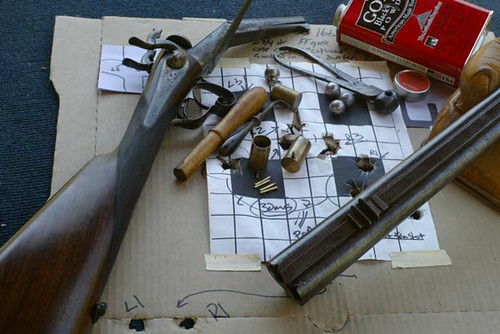| tinker |
| (.416 member) |
| 11/07/08 05:15 AM |

|
|
|
Daryl-
There are scores and scores of silver solder alloys.
For the rest of you, I'm speaking of high temperature *brazing* type silver solder, not the stuff you sweat your copper pipes together with during the hot water heater installation.
You'll see flow points from 1125F on up to the high 1700F range. The *ideal* clearance for each and any engineered silver solder product will be clearly outlined in the manufacturer's data sheet.
Some alloys will work best with .001", some will want more clearance for maximum strength, it's in the tech sheet for each brand and alloy.
One of the great things about there being so many different choices in flow point temperature is that the builder can choose an ultra high strength, high temp alloy for assembling the components of the lumps and 'monoblock', or shoe lumps, or dovetail lumps -- or whatever process he chooses, allowing for a series of construction where the 'next step' won't upset the 'last step' in the process.
Furthermore, if one is using 'monoblock' (sawn-off barrels at the chambers) method, absolutely perfect and perpendicular facing of the block-face to the bore and threads is easy if done in the same lathe or mill setup.
Just as well, the barrel-blanks can just as easily be *absolutely perfectly* faced perpendicular to the journal and threads.
If properly tinned, prepped and cleaned
(tin them in the lathe directly following the turning/threading process before tearing the setup down, then chase-off all but about .001 or .002" of the tinning)
then assembled with proper flux, the builder can use much lower melting, *not brazing* solder like 'force 44' from brownells and 'screw them tight as all get-out' and then get them up to working temperature to flow.
With perfectly perpendicularly faced barrels and block journals, peening and careful striking followed by good old fashioned rust black will net you the closest thing to 'invisible' results as you're going to get.
I've heard of guys going in there with a tig welder to blend the joint.
If I were tasked with that job I'd lightly bevel the block journals and the barrels (we're talking micro here).
I'd either turn or draw (on a shaper) strips of the barrel material to use as 'welding wire' for the operation.
The process would resemble fusion welding, but with a tad of filler so that it could be 'struck down' to the contour of the work.
I wouldn't suggest this for a couple of reasons.
1 - it'd be important to anneal the area of the fusion welds in order to assure they wouldn't crack later from the repeated stress of the gun or rifle firing, and that the temperature of that annealing would likely upset (boil) the solder in the barrel to block joint, also likely flow whatever hard solder there is in the chamber/lumps/quarterrib joint
2 - the contours of the barrels and chambers would have to be 99++% finished before the joining process was started - in that you could only do very, very minimal barrel striking at the tig welded joint as not to file completely through it while profiling the barrels later on.
Hope that makes sense.
Just machine them perfectly, screw them in and solder, then peen and strike for an 'invisible' finish.
You won't need solder 'tween the faces' of the chambers and the barrels. The solder will ideally already be in there from a properly done tinning joint in the first place.
--Tinker